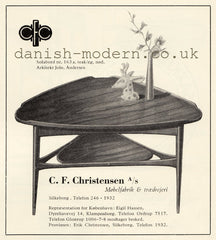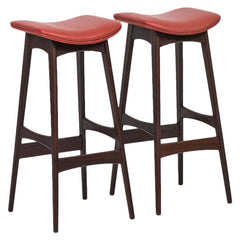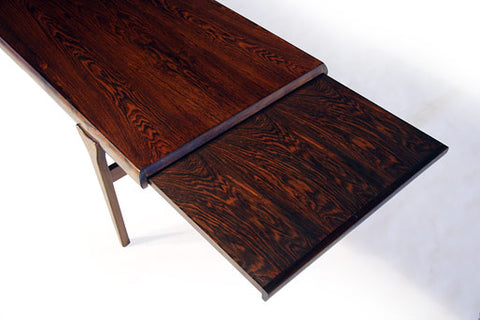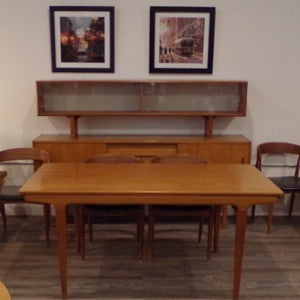Great Danish Designers 101: Johannes Andersen
What we now know as Danish mid-century design first emerged in the 1930s. The demand for authentic Danish mid-century pieces has never really waned since, making the products of many Danish designers especially valuable today. But what, in particular, is so appealing about Danish design? This new series of blog posts will help answer that question.
We’ll look first at some of the factors that influenced Scandinavian design in general and Danish design in particular before turning our attention to Johannes Andersen. A Danish designer, Andersen was grounded in the Scandinavian tradition but expanded his vision to create a truly distinct design aesthetic.
The Roots of Danish Modern Design
While specific Danish designers like Andersen developed their own style, they share common sources of influence. In her book Scandinavian Modern Home, Elizabeth Wilhide talks about the Scandinavian design ethos and how significantly it was influenced by climate and environment:
- Long dark winters in a mountainous and heavily forested land meant that nature and organic forms were a source of constant inspiration. As Wilhide wrote, “Nature, when it is this dramatic, cannot easily be ignored any more than it can be tamed.”
- With so much darkness in the fall and winter months, homes had to provide “psychological warmth” as well as physical shelter. “Domestic cheer” became an integral part of Scandinavian design, appearing in designs via colour, pattern, texture, or organic form. Even the most futuristic designs would include a strong human quality to provide that much-needed sense of warmth.
- In geographically isolated Scandinavian countries, resources could be in short supply. Furniture makers in the pre-modern era had to be efficient and minimize waste. Practicality also prevailed to ensure that the most was being made of scarce supplies. This mindset of “workable solutions with optimum economy” filtered down to the designers of the mid-century period.
- Given the remoteness of the area, industrialization arrived later in Scandinavia than in other parts of Europe. As a result, traditional craft skills remained an important part of the culture there. Even after industrial manufacturing was established, high standards of craftsmanship were upheld.
Denmark’s modern design movement owed much to this Scandinavian ethos, but also developed its own local flavour. While their northerly neighbours drew inspiration from the machine—which they saw as the emblem of the new age—Danish furniture makers were more focused on human-centred design. Pioneering Danish designer Kaare Klint even developed a set of data based on human measurements, proportions, and dimensions to act as a benchmark for furniture design. This human element was a major inspiration for many Danish designers, including Johannes Andersen.
Johannes Andersen: Ahead of the Curve
Andersen was born in Aarhus, Denmark in 1903. He apprenticed as a cabinet maker, becoming certified in 1922. By the mid-1930s, when Danish modern design rose in popularity beyond Denmark, he opened his own workshop. He continued to work with other design houses as well, including CFC Silkeborg in Denmark and Trensum in Sweden.
Scandinavian furniture was known for its distinctive shapes, flowing contours, and “restrained chic.” (Scandinavian Style) Andersen certainly followed this aesthetic in his designs. Looking at his work, it is also easy to see the influences of the culture and environment that surrounded him. The hallmarks of the Scandinavian ethos are present, but interpreted in a way that is Andersen’s alone.
Curves figured prominently in many of Andersen’s designs and he used them in novel and surprising ways. Consider his coffee tables. When most people think “coffee table,” they think of a rectangle or, if they are very imaginative, an oval. Not Andersen. He experimented with all kinds of unique shapes. His most famous is the Capri table, shown below. Like many of his tables, the Capri featured curved surfaces and bevelled edges that softened the design, showcasing the more organic approach to shape and form for which Danish designers, in particular, were known.
Distinct curves also appeared in his side tables, as seen in this 1954 advertisement, sourced from danish-modern.co.uk, and in Andersen’s futuristic “smile” table, at right.
The human dimension of Danish design is also present in Andersen’s furniture. He, like other Scandinavian designers, delivered practicality “without ever losing sight of the fact that furniture is used by human beings.” (Wilhide) Andersen’s attention to these “intangible human qualities” was especially apparent in the seating he created. His renowned Allegra barstool featured a concave seat designed to “cradle the body, creating the perfect balance between comfort and design.” (Pamono.ca)
The Capri sofa, perhaps Andersen’s most famous design and currently the most sought-after, showcases all of the elements for which he was known: a truly distinctive form, striking curves, and a design that “yields to the seated posture like a glove sliding onto a hand.”(Scandinavian Style)
Andersen’s dining room furniture was equally attentive to the human form. VHB is lucky enough to have in stock a set of Andersen’s dining chairs. The curved back is a hallmark of Scandinavian design and adds not only style, but also incredible comfort. Note as well the craftsmanship for which Andersen was known—the chairs are beautifully balanced both physically and visually.
Beyond the obvious comfort in his designs, Andersen—a quintessential Nordic designer—also included elements of practicality. Again, his coffee tables provide an example. He often added retractable shelves and drawers to his coffee tables to provide additional surface area or storage when needed.
The draw leaf design seen above also found its way into Andersen’s dining tables, including a solid teak table currently available at VHB. Like his other tables, this one features rounded edges on the table top and curves where the legs meet the table to soften the entire look. In a further testament to Andersen’s skill as a craftsman, the draw leaves fit beautifully under the surface—so much so that they are practically invisible when retracted.
Johannes Andersen garnered international acclaim in his lifetime that is still accorded to him today. Current collectors pay top dollar for his furniture, in appreciation of its exceptional quality and visually stunning design elements.
The next designer in our series: Kai Kristiansen, designer of the famous #42 dining chair currently in stock at VHB.
This post was written by guest blogger Crystal Smith of Pertingo Content Marketing.













Leave a comment